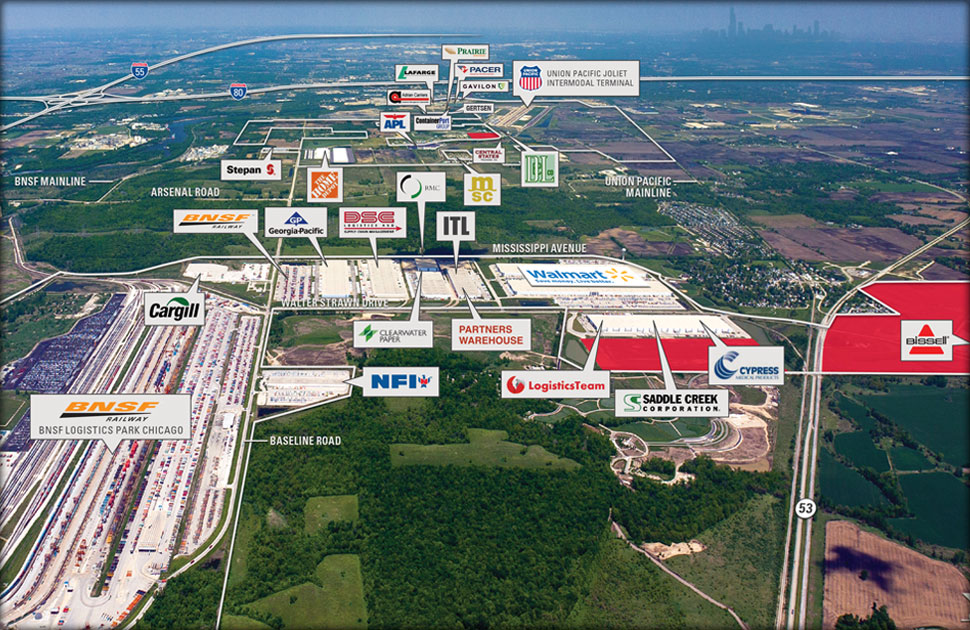 original here
original here
Chicago is the rail hub of North America: the only place where six of the continent’s eight Class I railway networks meet (see this fascinating continental rail map). Some 500 freight trains converge on the city every day, around a third of total US volume. None of the major rail networks spans the entire continent, so ongoing freight must be transferred from one line to the other, whether in switching yards (for bulk loads) or by short-haul truck (for containers). Even more importantly, manufactured goods for Midwestern consumption must be transferred by truck to warehouses and from there, to smaller distribution centers or directly to the stores. Chicago therefore becomes the very definition of intermodalism, which simply means the switch from one form of transport to another (and less simply, from one corporation to the other). In the same blow, Chicago proves that you don’t need an ice-free harbor to be a world-class port these days. In fact, metropolitan Chicagoland is the world’s third-busiest intermodal port, after the Asian seaports of Singapore and Hong Kong.
For rail and truck traffic, Chicago is also the definition of snarl. Some 700 hundred passenger trains traverse the region each day, sharing tracks and bridges with the 500 freight trains. Around 30,000 cars are switched daily. Every container-laden truck has to battle for space on highways clogged with commuter traffic from the suburbs. It takes two days for a container to arrive here from the West Coast, but it can take thirty hours to cross Chicagoland (which is a big improvement compared to fifteen years ago). The volume of traffic has surged since the 1990s, but much of the infrastructure is poorly maintained and outdated. Since the late nineteenth century when the congestion problem began, new facilities have tended to be located increasingly further from the Loop. The mutually owned Belt Railway and Clearing Yard were steps along the pathway leading to today’s peripheral terminals. However, in 1999 a more or less typical snowstorm (22 inches following by subzero temperatures) was still able to back up traffic for several months, not just in the city, but in the entire nation. The problem was not so much the storm itself, but the saturation of North America’s crucial rail hub. This wake-up call was the impetus for the Chicago Transportation Coordination Office, or CTCO, which harmonizes maintenance activities and emergency response strategies among the different lines, followed by the Chicago Region Environmental and Transportation Efficiency Program, aka CREATE, which aims to fix the worst of the infrastructure problems in the city proper.
Obviously, the rail companies did not wait for public officials to solve the problem. Instead they have created mammoth logistics parks on the peripheries of the six-county region, adding another giant step to the historic movement out of the downtown Loop. The largest of these next-generation switching platforms has been developed by the CenterPoint corporation on the superfund site of a former arsenal just south of Joliet, near the junction of Interstate Highways 80 and 55. The CenterPoint site associates two major intermodal terminals – BNSF and Union Pacific – with a vast warehouse district and a host of supporting companies. A master plan lists 28 tenants of the double site, all of which are major distributors, industrial corporations or logistics firms. To sweeten the neoliberal deal, the entire development has been pre-designated for Foreign Trade Zones and Enterprise Zones, so as to minimize both tariffs and labor costs.
WalMart’s warehouse complex alone totals 3.4 million square feet. Under its immense double nave, and in similar facilities throughout the region, subcontracted workers are faced with abysmal labor conditions that have only recently been challenged by the formation of Warehouse Workers for Justice. In post-industrial America, the real work – often done by undocumented migrants – is unloading, repackaging, reloading and transshipping the flood of consumer goods coming from Asia. And there’s plenty of work, both physical and political, to be done at Chicago’s intermodal terminals.
